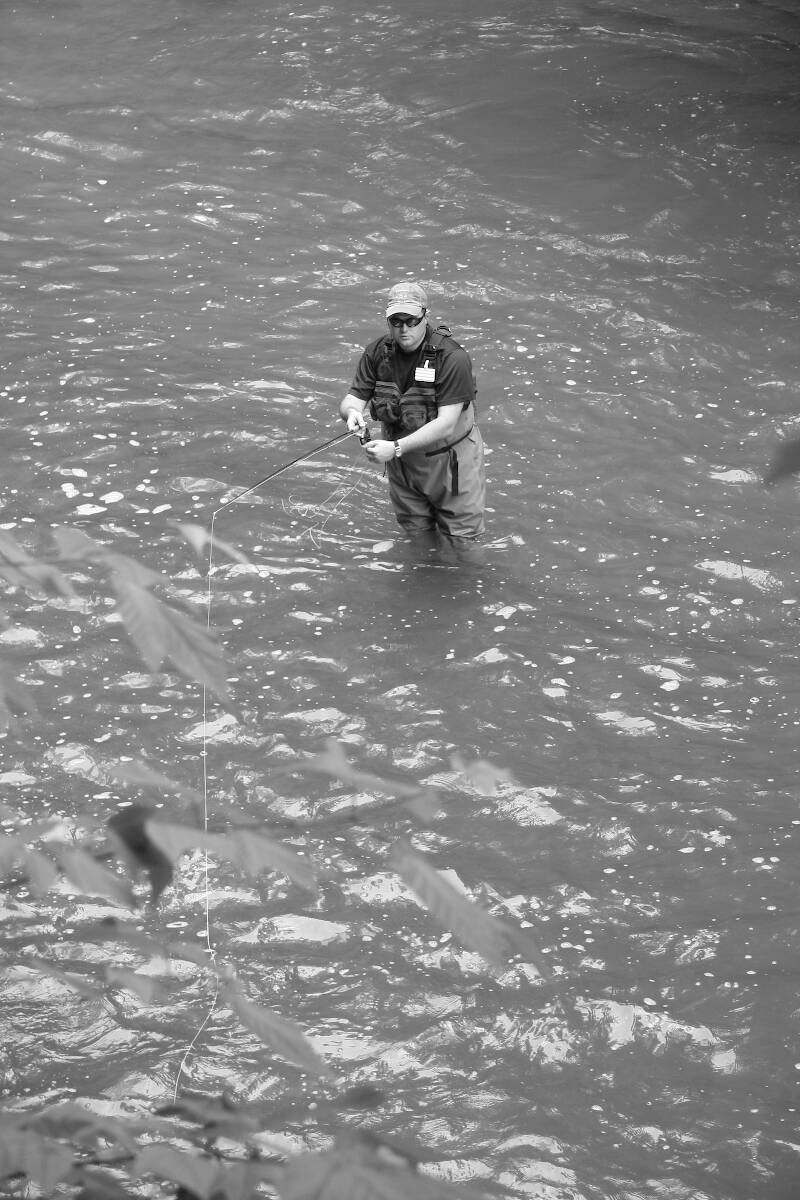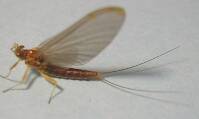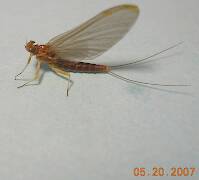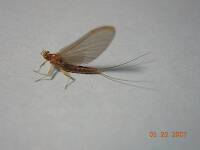
Salmonflies
Pteronarcys californica
The giant Salmonflies of the Western mountains are legendary for their proclivity to elicit consistent dry-fly action and ferocious strikes.
Featured on the forum

This specimen keys to the Epeorus albertae group of species. Of the five species in that group, the two known in Washington state are Epeorus albertae and Epeorus dulciana. Of the two, albertae has been collected in vastly more locations in Washington than dulciana, suggesting it is far more common. On that basis alone I'm tentatively putting this nymph in albertae, with the large caveat that there's no real information to rule out dulciana.

Troutnut is a project started in 2003 by salmonid ecologist Jason "Troutnut" Neuswanger to help anglers and
fly tyers unabashedly embrace the entomological side of the sport. Learn more about Troutnut or
support the project for an enhanced experience here.
Mad4fish on Nov 26, 2008November 26th, 2008, 5:17 am EST
A quick question to any of my fellow fly fishing enthusiasts across the Atlantic (I'm from Westmeath in Ireland).
A dry fly that i like to call "old reliable" the Cockabundy, is used on most rivers here in Ireland by myself during the open Trout season (March to September).
My question is have any of you guys over in the US heard of or ever tried this fly on your rivers.
I've found it to be a great fly during the evening "rise" and was just wondering if your US Trout have the same tastes in flies as ours here in Ireland.
Regards,
mad4fish
mad4fish
SlateDrake9 on Nov 26, 2008November 26th, 2008, 10:00 am EST
That's a new name to me, but that doesn't mean that I haven't seen or used the fly, just by a different name. Got a picture and list of materials?
Fishing with bait is like swearing in church.
-- Slate Drake
-- Slate Drake
Mad4fish on Nov 26, 2008November 26th, 2008, 1:45 pm EST
SlateDrake 9.
Thank you for your reply to my query. I do have Cockabundy flies (by the dozen) in my boxes.
Firstly in Ireland there are variations of how to tie them (materials,hooks, wet dry etc).
Secondly. I will send a number of pictures of this fly with as much detail as i can regarding it's tying ASAP.
Thirdly, although i'm fly fishing for a time (no smart comments please) the materials used i'll have to get from my mentor, which can be hard as a number of tackle shops here in Westmeath in Ireland are looking for him to divulge his fly tying materials and methods.
But none the less.
I posted the query so therefor i'll see it through to the end.
As it's now 2.45am here in Irelan i'll post all i have within 24hours.
Thank you again for replying to my query and i hope to speak with you soon.
Kind Regards,
mad4fish.
mad4fish
SlateDrake9 on Dec 1, 2008December 1st, 2008, 10:06 am EST
I'm waiting :-)
Fishing with bait is like swearing in church.
-- Slate Drake
-- Slate Drake
Martinlf on Dec 2, 2008December 2nd, 2008, 12:34 pm EST
Me too. :o
"He spread them a yard and a half. 'And every one that got away is this big.'"
--Fred Chappell
--Fred Chappell
Flatstick96 on Mar 12, 2009March 12th, 2009, 4:53 am EDT
I think he's referring to a fly that I've seen called "Coch y Bonddu".
Coch y Bonddu is the Welsh name for a particular beetle that I think is the same (or similar to) what we commonly call a "Japanese Beetle" here.
Here is how I first became familiar with it...
Summer of 2002 was when I really got back into fly-fishing; I'd just moved back to the northeast (State College) after a five year stint in Austin, TX and I was hell-bent on making the most of again living in close proximity to good trout streams. (I say "again" because prior to my Texas folly, I spent an absurd portion of my youth scrambling around Enfield Glen in Robert H. Treman State Park - I know there are at least a few of you guys here who are familiar with that stream.)
Until my arrival in SC I'd never fished terrestrials, but that summer I leaned heavily on knowledge gleaned from the guys at FFP; and when the water started to get lower and slower, terrestrials were one of their most common recommendations - so I bought two wet black ants from Steve and hit Spring Creek (with some skepticism, I might add). I remember the day well - I was catching a few on my usual assortment of nymphs, but pickings overall were pretty slim, so I decided to give the wet black ant a try. After hooking fish on my first four casts, I was sold on the fly's effectiveness - "unfortunately" two of the four were pretty big fish, and they snapped me off, leaving my with exactly ZERO wet black ants. So I'm standing in the middle of the stream thinking "Great, now what?"
The next thought was "What do I have in my meager fly supply that might look even a little like a terrestrial?"
I've always been very much a minimalist when it comes to my fly box, and that particular summer, coming off my 5 year trout hiatus, my box was particularly sparse. After about a 2 second scan of my entire available inventory, I noticed the row of ratty looking flies that I'd gotten from my grandfather many years before (none of which I'd ever bothered to fish). Tucked in there was a VERY simple, very tattered looking fly that had what looked like a herl body ribbed with wire, with a sparse brown hackle in front of it - and that was it. I thought "Well, that kinda looks like it could be a beetle, or a fly, or something - let's try it."
I took it out to find that the hook had long since rusted, so I cleaned and sharpened it up as best I could, tied it on, and tossed it up into the spot where the ant had just been so effective. The truth is, I wasn't expecting it to yield any results, but I got a strike almost immediately. It was a memorable experience, because it was the first of many times that I had the pleasure of hooking into what I call Spring Creek's "Freight Trains" - I got a great look at that Brown's broad back as he torpedoed right past my legs on his way downstream. I played him for a few seconds, but I didn't stand a chance - the line soon went limp. When I reeled in, I noticed that the fly was still attached - the old hook had broken off right at the top of the bend.
When I got home that afternoon I scoured as many online fly databases as I could find, until I saw a photo that matched what I'd tied on that day, and the photo identified the fly as the "Coch y Bonddu".
You can see a picture of it here:
http://www.danica.com/flytier/tlogan/coch-y-bonddu.htm
Coch y Bonddu is the Welsh name for a particular beetle that I think is the same (or similar to) what we commonly call a "Japanese Beetle" here.
Here is how I first became familiar with it...
Summer of 2002 was when I really got back into fly-fishing; I'd just moved back to the northeast (State College) after a five year stint in Austin, TX and I was hell-bent on making the most of again living in close proximity to good trout streams. (I say "again" because prior to my Texas folly, I spent an absurd portion of my youth scrambling around Enfield Glen in Robert H. Treman State Park - I know there are at least a few of you guys here who are familiar with that stream.)
Until my arrival in SC I'd never fished terrestrials, but that summer I leaned heavily on knowledge gleaned from the guys at FFP; and when the water started to get lower and slower, terrestrials were one of their most common recommendations - so I bought two wet black ants from Steve and hit Spring Creek (with some skepticism, I might add). I remember the day well - I was catching a few on my usual assortment of nymphs, but pickings overall were pretty slim, so I decided to give the wet black ant a try. After hooking fish on my first four casts, I was sold on the fly's effectiveness - "unfortunately" two of the four were pretty big fish, and they snapped me off, leaving my with exactly ZERO wet black ants. So I'm standing in the middle of the stream thinking "Great, now what?"
The next thought was "What do I have in my meager fly supply that might look even a little like a terrestrial?"
I've always been very much a minimalist when it comes to my fly box, and that particular summer, coming off my 5 year trout hiatus, my box was particularly sparse. After about a 2 second scan of my entire available inventory, I noticed the row of ratty looking flies that I'd gotten from my grandfather many years before (none of which I'd ever bothered to fish). Tucked in there was a VERY simple, very tattered looking fly that had what looked like a herl body ribbed with wire, with a sparse brown hackle in front of it - and that was it. I thought "Well, that kinda looks like it could be a beetle, or a fly, or something - let's try it."
I took it out to find that the hook had long since rusted, so I cleaned and sharpened it up as best I could, tied it on, and tossed it up into the spot where the ant had just been so effective. The truth is, I wasn't expecting it to yield any results, but I got a strike almost immediately. It was a memorable experience, because it was the first of many times that I had the pleasure of hooking into what I call Spring Creek's "Freight Trains" - I got a great look at that Brown's broad back as he torpedoed right past my legs on his way downstream. I played him for a few seconds, but I didn't stand a chance - the line soon went limp. When I reeled in, I noticed that the fly was still attached - the old hook had broken off right at the top of the bend.
When I got home that afternoon I scoured as many online fly databases as I could find, until I saw a photo that matched what I'd tied on that day, and the photo identified the fly as the "Coch y Bonddu".
You can see a picture of it here:
http://www.danica.com/flytier/tlogan/coch-y-bonddu.htm
DOS on Mar 12, 2009March 12th, 2009, 9:17 am EDT
Flatstick great story! That fly looks great.... looking forward to trying it, i like the red head and often do that on many of my drys
Andrew Nisbet
Martinlf on Mar 13, 2009March 13th, 2009, 5:12 am EDT
Hey Flatstick,
I've been broken off in similar fashion on Spring Creek. Loved your story.
--Louis
I've been broken off in similar fashion on Spring Creek. Loved your story.
--Louis
"He spread them a yard and a half. 'And every one that got away is this big.'"
--Fred Chappell
--Fred Chappell
Wbranch on Mar 16, 2009March 16th, 2009, 1:13 am EDT
Isn't "Cockabundy" also a color/pattern of dry fly hackle? I'm thinking it is furnace brown with a black center.
Edited -
I have a memory like a steel trap! I knew I'd seen it written somewhere that there was a hackle color by a name similar to this "Cockabundy".
I searched most of my old fly tying books and was about to give up when I saw a 1961 edition of Herter's "Professional Fly Tying, Spinning, and Tackle Making Manual" and lo and behold on page 63 discussing "Colors of Hackle" is written the following;
"Cock-Y-Bonhu: This a a type of furnace hackle. It is a furnace hackle that is brown with a black streak down the center. The edges of the hackle fibers and the tips are black. The name originated in Scotland and was taken from the name of the Cock-y-bondhu fly which was made to imitate a small red and black beetle native to parts of Scotland."
Edited -
I have a memory like a steel trap! I knew I'd seen it written somewhere that there was a hackle color by a name similar to this "Cockabundy".
I searched most of my old fly tying books and was about to give up when I saw a 1961 edition of Herter's "Professional Fly Tying, Spinning, and Tackle Making Manual" and lo and behold on page 63 discussing "Colors of Hackle" is written the following;
"Cock-Y-Bonhu: This a a type of furnace hackle. It is a furnace hackle that is brown with a black streak down the center. The edges of the hackle fibers and the tips are black. The name originated in Scotland and was taken from the name of the Cock-y-bondhu fly which was made to imitate a small red and black beetle native to parts of Scotland."
Catskill fly fisher for fifty-five years.
Flatstick96 on Mar 16, 2009March 16th, 2009, 4:06 am EDT
Thanks Louis.
Spring has some great fish.
Spring has some great fish.
Flatstick96 on Mar 16, 2009March 16th, 2009, 4:08 am EDT
Wbranch,
Thanks for that information, I guess that would be the hackle used - to me it just looked brown, but the fly I had was VERY old, and I know very little about hackle anyway.
Thanks for that information, I guess that would be the hackle used - to me it just looked brown, but the fly I had was VERY old, and I know very little about hackle anyway.
Shawnny3 on Mar 16, 2009March 16th, 2009, 9:10 am EDT
Now that you describe it, Matt, I realize that I have some of that hackle. Mine isn't really flytying hackle (just from an English Bantam someone gave me), but it's a beautiful feather and I might see if I have some with barbs short enough to tie up the Coch y Bonddu. I was just intending on making a cool-looking streamer with it.
-Shawn
-Shawn
Jewelry-Quality Artistic Salmon Flies, by Shawn Davis
www.davisflydesigns.com
www.davisflydesigns.com
Martinlf on Mar 17, 2009March 17th, 2009, 2:16 am EDT
I just came across a reference to a "Cochy Bondhu Quill" in a 1963 book by Charlie Fox, The Wonderful World of Trout, page 21. He's describing the fly for a "Chocolate Drake" or "Ephemera similans." He describes using the "cocky bondhu" quill for the body, and he also refers to "cochy bondhu hackle wisps" for the tail and "cochy bondhu" to hackle the fly.
"He spread them a yard and a half. 'And every one that got away is this big.'"
--Fred Chappell
--Fred Chappell
Shawnny3 on Mar 17, 2009March 17th, 2009, 8:22 am EDT
Nice. Thanks for the other tying ideas, Louis.
-Shawn
-Shawn
Jewelry-Quality Artistic Salmon Flies, by Shawn Davis
www.davisflydesigns.com
www.davisflydesigns.com
Twofeathers on Nov 16, 2009November 16th, 2009, 5:29 am EST
Plate ‘A’ of ‘Favorite Flies and Their Histories’ by Mary Orvis Marbury, item 9 is a Coch-y-Bonddu Hackle fly. Very similar to a Brown Hackle, i.e., peacock herl body tied with brown silk, a small tag of tying thread and a sparsely wrapped Coch-y-bonddu hackle with a small brown head. It is an imitation of a small beetle, sometimes called the Bracken-clock. Coch-y-Bonddu hackle is brown with a black quill and black tips. It can be made with a black waterproof marker and brown hackle. Use a straight edge and dot the fibers, do not draw a line down the fibers as individual fibers may be pulled in and an uneven line will result. The fibers, herl, should be perpendicular to the quill. Do one side of the quill and then the other and finish with the tips. If a darker quill is needed, turn the feather over and repeat on the other side.
I found a furnace style hackle that has a black quill in 2007 at the Denver Fly Fishing show. Also, have a Metz #2 Microbarb Saddle Brown that has a black quill.
I found a furnace style hackle that has a black quill in 2007 at the Denver Fly Fishing show. Also, have a Metz #2 Microbarb Saddle Brown that has a black quill.
Tilman on Dec 7, 2009December 7th, 2009, 5:26 am EST
Today i stumbled upon this thread and now i have the first finished example in the vice. The first hackle material i used was the brown partridge i had, but the next hackle will be metz.
For all of you out there, who use different colours of metz saddles, i have found a very obvious way to get every colour i need from just one saddle:
I use a waterproof markerpen (e.g. edding). I just need one saddle, really, the grizzly (as it´s the most common used) and maybe someday i´ll get another saddle in plain white.
If you´re interested in a photo, i´ll see what i can do.
I think i can match the Coch-Y-Bonddu from the daica.com site (which often inspires me.
For all of you out there, who use different colours of metz saddles, i have found a very obvious way to get every colour i need from just one saddle:
I use a waterproof markerpen (e.g. edding). I just need one saddle, really, the grizzly (as it´s the most common used) and maybe someday i´ll get another saddle in plain white.
If you´re interested in a photo, i´ll see what i can do.
I think i can match the Coch-Y-Bonddu from the daica.com site (which often inspires me.
Walleye on Apr 11, 2010April 11th, 2010, 4:12 pm EDT
Back in the 70's I was fishing on the Letort (linestone stream), on the section called Fox's Waters, which was owned and maintained by Charlie Fox, (author, fisherman, 1 st TU member in PENN.). Well Charlie would often come down and talk to you while you fished. This one day some Baetis were coming off and my fly did not do the trick. Charlie offered me a fly " calling it a "cocky-bundo-quill". It was about a #20 or 18, He later gave me a second one and told me that they had been tied by Ray Bergman, and given to him (Charlie)years before. So yes the hackle color use to be found in fly shops but I have not seen it in many years. True story I now have the flies in my collection.
Every trout is a trophy!
Quick Reply
Related Discussions
Topic
Replies
Last Reply
4
Dec 22, 2009
by Oldredbarn
by Oldredbarn
Re: Three Trouble Makers at the Midwest Fly Fishing Expo the past weekend
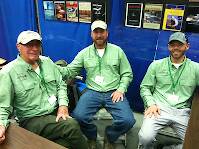
In the Photography Board by Oldredbarn

In the Photography Board by Oldredbarn
3
Mar 11, 2014
by TNEAL
by TNEAL
5
Aug 20, 2009
by Flytyer0423
by Flytyer0423



